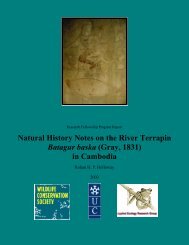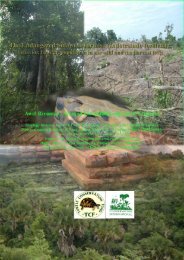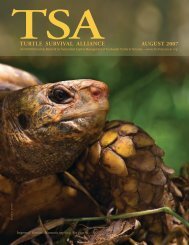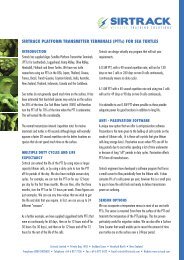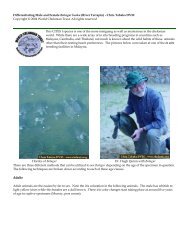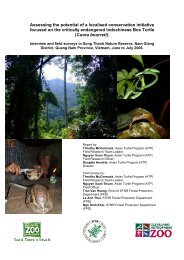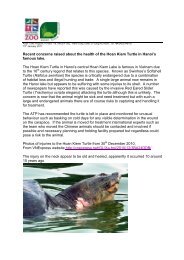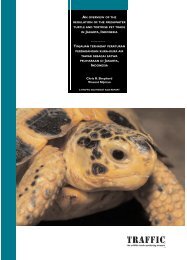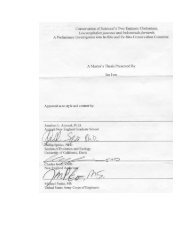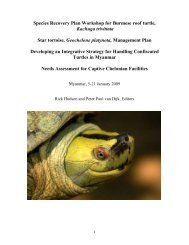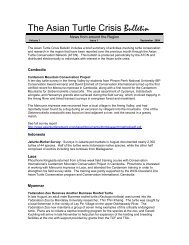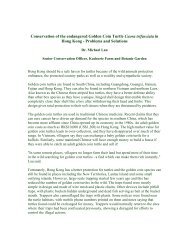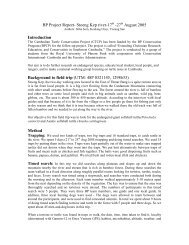Turtle Conservation Fund - Species Recovery Plan for Batagur baska
Turtle Conservation Fund - Species Recovery Plan for Batagur baska
Turtle Conservation Fund - Species Recovery Plan for Batagur baska
Create successful ePaper yourself
Turn your PDF publications into a flip-book with our unique Google optimized e-Paper software.
Number of founders (those wild-caught animals that have successfully<br />
reproduced in captivity) and potential founders (those wild-caught animals that<br />
have not yet reproduced in captivity) existing and number needed: Fifteen<br />
potential and at least two founders exist in North American collections. It is<br />
unknown if there is more than one founder male, as the founder female at the<br />
Bronx Zoo was housed with several males at the times of her reproductive events.<br />
Although the International <strong>Species</strong> Inventory System (ISIS) shows 79 specimens<br />
exist in Asian collections (Table 1), the number of founders and potential founders<br />
is not yet known. However, there are about 50 – 100 mature, wild collected<br />
animals plus hundreds of captive-hatched offspring, some approaching maturity, in<br />
Thailand, with larger numbers in Malaysia (see above descriptions of Asian<br />
facilities) (P.P. van Dijk, personal communication). There<strong>for</strong>e, if large holdings of<br />
founders and potential founders exist in these collections, there may already be<br />
enough animals in captivity to meet the genetic goal of this program. Problem:<br />
Populations from the Andaman Sea – Straits of Malacca may be genetically<br />
different from South China Sea populations, and animals from different coasts<br />
have certainly been brought together in the Satun Breeding Centre in Thailand and<br />
possibly stock or hatchlings have been moved between river basins within<br />
Peninsular Malaysia. Meanwhile, these Thai-Malay animals are definitely<br />
recognizably different from India-Bangladeshi animals (which almost certainly are<br />
not in western collections) (P.P. van Dijk, personal communication).<br />
Origin and location of founders and potential founder specimens: There are<br />
minimally two founders in North American collections, and these are both held at<br />
the Wildlife <strong>Conservation</strong> Society – Bronx Zoo. The number of founders and<br />
potential founders in Asian institutions is unknown at this time (Table 1).<br />
Target Population Size, i.e., the number of specimens required to maintain a<br />
genetically viable and demographically stable captive population. This number<br />
will be based on the reproductive and life history characteristics of the<br />
particular species, and may require the input of a biologist with small<br />
population management experience. A population analysis has not yet been<br />
conducted <strong>for</strong> this species. Few data <strong>for</strong> such an analysis are available, making<br />
the results speculative at best. Based on the longevity and fecundity of this<br />
species, a target population size of 100 is probably sufficient to meet our genetic<br />
goal. There<strong>for</strong>e, our arbitrary population size of 300 should be more than<br />
adequate to sustain this species. As further population data are available on<br />
<strong>Batagur</strong>, analyses will be conducted to further refine the target population size.<br />
Caution must be taken to not allow this species to needlessly consume limited<br />
space available <strong>for</strong> other large riverine <strong>for</strong>ms (i.e., Callagur, Orlitia). Attaining<br />
our goal of maintaining 300 turtles will require recruiting partners with additional<br />
indoor or year round outdoor facilities with adequate space, and in <strong>for</strong>ming<br />
partnerships with Asian institutions such as Singapore Zoological Gardens, Khao



